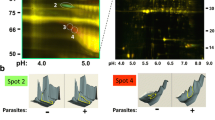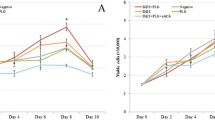Abstract
Schistosomes are parasitic platyhelminths that currently infect over 200 million people and cause the chronic debilitating disease schistosomiasis. While these large intravascular parasites can disturb blood flow, surprisingly they do not appear to provoke thrombus formation around them in vivo. In order to determine if the worms can alter their local environment to impede coagulation, we incubated adult worms (50 pairs) in murine blood (500 µl) for 1 h at 37 °C and, using thromboelastography (TEG), we compared the coagulation profile of the blood with control blood that never contained worms. Substantial differences were apparent between the two profiles. Blood that had been exposed to schistosomes clotted more slowly and yielded relatively poor, though stable, thrombi; all TEG measures of blood coagulation (R, K, α-angle, MA, G and TMA) differed significantly between conditions. No fibrinolysis (as determined by LY30 and LY60 values) was detected in either case. The observed TEG profile suggests that the worms are acting as local anti-coagulants. Blood recovered from schistosome-infected mice, however, does not behave in this way. At an early time point post infection (4-weeks), the TEG profile of infected murine blood is essentially the same as that of control blood. However at a later time point (7-weeks) infected murine blood clots significantly faster than control blood but these clots also break down faster. The R, K, α-angle, and TMA measures of coagulation are all significantly different between the control versus infected mice as are the LY30 and LY60 values. This profile is indicative of a hypercoagulable state with fibrinolysis and is akin to that seen in human patients with advanced schistosomiasis.


Similar content being viewed by others
References
Vennervald BJ, Dunne DW (2004) Morbidity in schistosomiasis: an update. Curr Opin Infect Dis 17:439–447
King CH, Dangerfield-Cha M (2008) The unacknowledged impact of chronic schistosomiasis. Chronic Illn 4:65–79
Colley DG, Bustinduy AL, Secor WE, King CH (2014) Human schistosomiasis. Lancet 383:2253–2264
Keating J, Wilson R, Skelly P (2006) No overt cellular inflammation around intravascular schistosomes in vivo. J Parasitol 92(6):1365–1369
Wu YP, Lenting PJ, Tielens AG, de Groot PG, van Hellemond JJ (2007) Differential platelet adhesion to distinct life-cycle stages of the parasitic helminth Schistosoma mansoni. J Thromb Haemost 5:2146–2148
Yeaman M, Bayer A (2007) Antimicrobial host defense. In: Michelson A (ed) Platelets, 2nd edn. Academic Press, Burlington, pp 727–755
Bolliger D, Seeberger MD, Tanaka KA (2012) Principles and practice of thromboelastography in clinical coagulation management and transfusion practice. Transfus Med Rev 26:1–13
Tucker MS, Karunaratne LB, Lewis FA, Freitas TC, Liang YS. Schistosomiasis. Current protocols in immunology/ed Coligan JE et al. 2013;103:Unit 19 1
MacDonald SG, Luddington RJ (2010) Critical factors contributing to the thromboelastography trace. Semin Thromb Hemost 36:712–722
Leite LA, Pimenta Filho AA, Martins da Fonseca CS, Santana dos Santos B, Ferreira Rde C, Montenegro SM et al (2013) Hemostatic dysfunction is increased in patients with hepatosplenic schistosomiasis mansoni and advanced periportal fibrosis. PLoS Negl Trop Dis 7:e2314
Omran SA, Amer AM, el-Kaliouby AH, Eldin AA (1991) Study of contact activation in endemic hepatosplenomegaly. Blood Coagul Fibrinolysis 2:659–662
El-Bassiouni NE, El Bassiouny AE, Hussein NA, El-Sayed HH, Ibrahim IM, Lotfy MG et al (1998) The coagulation profile in hepatosplenic schistosomiasis. Blood Coagul Fibrinolysis 9:189–194
Souza MR, Toledo CF, Borges DR (2000) Thrombocytemia as a predictor of portal hypertension in schistosomiasis. Dig Dis Sci 45:1964–1970
Ngaiza JR, Doenhoff MJ (1987) Schistosoma mansoni-induced thrombocytopenia in mice. Trans R Soc Trop Med Hyg 81:655–656
Vasconcelos EG, Nascimento PS, Meirelles MN, Verjovski-Almeida S, Ferreira ST (1993) Characterization and localization of an ATP-diphosphohydrolase on the external surface of the tegument of Schistosoma mansoni. Mol Biochem Parasitol 58:205–214
Vasconcelos EG, Ferreira ST, Carvalho TM, Souza W, Kettlun AM, Mancilla M et al (1996) Partial purification and immunohistochemical localization of ATP diphosphohydrolase from Schistosoma mansoni. Immunological cross-reactivities with potato apyrase and Toxoplasma gondii nucleoside triphosphate hydrolase. J Biol Chem 271:22139–22145
Da’dara AA, Bhardwaj R, Ali YBM, Skelly P (2014) Schistosome tegumental ecto-apyrase (SmATPDase1) degrades exogenous pro-inflammatory and pro-thrombotic nucleotides. PeerJ. 2:e316. doi:10.7717/peerj.316
Bhardwaj R, Skelly PJ (2009) Purinergic signaling and immune modulation at the schistosome surface? Trends Parasitol 25:256–260
Lin YL, He S (2006) Sm22.6 antigen is an inhibitor to human thrombin. Mol Biochem Parasitol 147:95–100
Blanton RE, Licate LS, Aman RA (1994) Characterization of a native and recombinant Schistosoma haematobium serine protease inhibitor gene product. Mol Biochem Parasitol 63:1–11
Braschi S, Wilson RA (2006) Proteins exposed at the adult schistosome surface revealed by biotinylation. Mol Cell Proteomics 5:347–356
Braschi S, Curwen RS, Ashton PD, Verjovski-Almeida S, Wilson A (2006) The tegument surface membranes of the human blood parasite Schistosoma mansoni: a proteomic analysis after differential extraction. Proteomics 6:1471–1482
Braschi S, Borges WC, Wilson RA (2006) Proteomic analysis of the schistosome tegument and its surface membranes. Mem Inst Oswaldo Cruz 101(Suppl 1):205–212
Robertson NP, Cain GD (1985) Isolation and characterization of glycosaminoglycans from Schistosoma mansoni. Comp Biochem Physiol B 82:299–306
Salafsky B, Fusco AC (1987) Schistosoma mansoni: a comparison of secreted vs nonsecreted eicosanoids in developing schistosomulae and adults. Exp Parasitol 64:361–367
Angeli V, Faveeuw C, Roye O, Fontaine J, Teissier E, Capron A et al (2001) Role of the parasite-derived prostaglandin D2 in the inhibition of epidermal Langerhans cell migration during schistosomiasis infection. J Exp Med 193:1135–1147
Smith JB, Silver MJ, Ingerman CM, Kocsis JJ (1974) Prostaglandin D2 inhibits the aggregation of human platelets. Thromb Res 5:291–299
Ramajo-Hernandez A, Perez-Sanchez R, Ramajo-Martin V, Oleaga A (2007) Schistosoma bovis: plasminogen binding in adults and the identification of plasminogen-binding proteins from the worm tegument. Exp Parasitol 115:83–91
de la Torre-Escudero E, Manzano-Roman R, Perez-Sanchez R, Siles-Lucas M, Oleaga A (2010) Cloning and characterization of a plasminogen-binding surface-associated enolase from Schistosoma bovis. Vet Parasitol 173:76–84
de la Torre-Escudero E, Manzano-Roman R, Siles-Lucas M, Perez-Sanchez R, Moyano JC, Barrera I et al (2012) Molecular and functional characterization of a Schistosoma bovis annexin: fibrinolytic and anticoagulant activity. Vet Parasitol 184:25–36
Carvalho WS, Lopes CT, Juliano L, Coelho PM, Cunha-Melo JR, Beraldo WT et al (1998) Purification and partial characterization of kininogenase activity from Schistosoma mansoni adult worms. Parasitology 117(Pt 4):311–319
Maurer M, Bader M, Bas M, Bossi F, Cicardi M, Cugno M et al (2011) New topics in bradykinin research. Allergy 66:1397–1406
Acknowledgments
This work was funded by NIH-NIAID Grant AI056273. Infected snails were provided by BRI via the NIAID schistosomiasis resource center under NIH-NIAID Contract No. HHSN272201000005I. We thank Qiang Wang for technical assistance.
Author contribution
Conceived and designed the experiments: A. A. Da’dara and P. J. Skelly. Performed the experiments: A. A. Da’dara. Analyzed the data: A. A. Da’dara, A. M. de Laforcade, P. J. Skelly. Wrote the paper, A. A. Da;’dara, P. J. Skelly.
Author information
Authors and Affiliations
Corresponding author
Rights and permissions
About this article
Cite this article
Da’dara, A.A., de Laforcade, A.M. & Skelly, P.J. The impact of schistosomes and schistosomiasis on murine blood coagulation and fibrinolysis as determined by thromboelastography (TEG). J Thromb Thrombolysis 41, 671–677 (2016). https://doi.org/10.1007/s11239-015-1298-z
Published:
Issue Date:
DOI: https://doi.org/10.1007/s11239-015-1298-z




